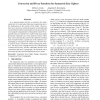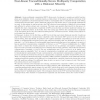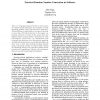77 search results - page 5 / 16 » The gap between cryptography and information security |
ACNS
2009
Springer
14 years 2 months ago
2009
Springer
Abstract. Two-party Secure Function Evaluation (SFE) is a very useful cryptographic tool which allows two parties to evaluate a function known to both parties on their private (sec...
ITCC
2005
IEEE
14 years 1 months ago
2005
IEEE
As a general design criterion, a symmetric key cipher should not be closed under functional composition due to the implications on the security of the cipher. However, there are s...
STORAGESS
2006
ACM
14 years 1 months ago
2006
ACM
Archival storage systems are designed for a write-once, read-maybe usage model which places an emphasis on the long-term preservation of their data contents. In contrast to tradit...
IACR
2011
12 years 7 months ago
2011
Secure multiparty computation (MPC) allows a set of n players to compute any public function, given as an arithmetic circuit, on private inputs, so that privacy of the inputs as we...
ACSAC
2003
IEEE
14 years 25 days ago
2003
IEEE
There is a large gap between the theory and practice for random number generation. For example, on most operating systems, using /dev/random to generate a 256-bit AES key is highl...



